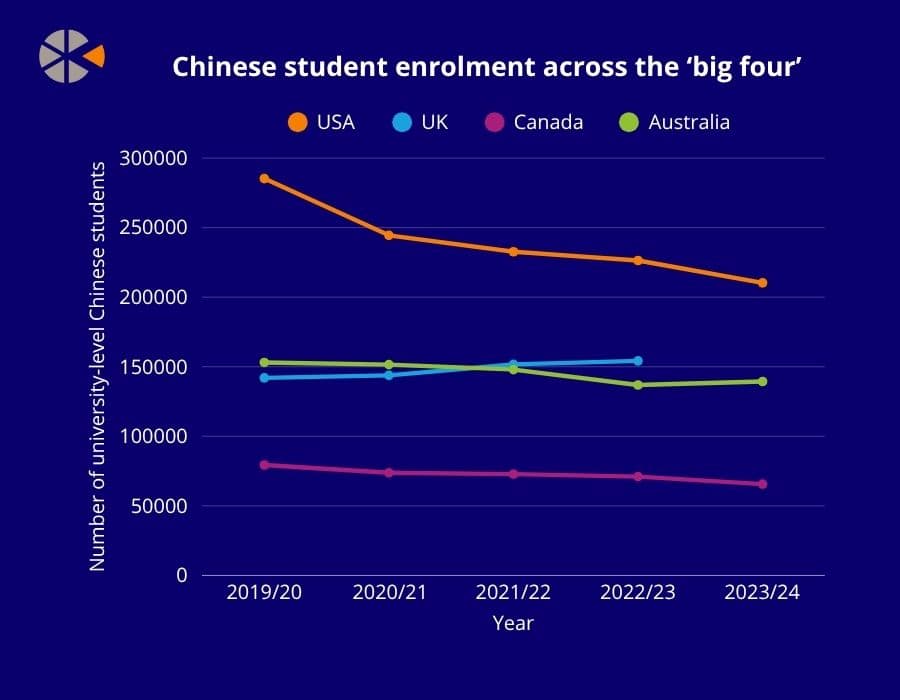Are Chinese students losing interest in the ‘big four’?
Once the world’s largest source of international students, China is no longer expected to fuel further student growth in the ‘big four’ destinations, according to predictions from Bonard Education shared in a recent webinar.
“China is no longer the easy goldmine it once was”, Bonard senior research consultant, Su Su, told attendees, highlighting the “visible trend” of Chinese students choosing alternative options closer to home.
The US has seen the most noticeable decline in Chinese enrolments, which broadly started across traditional destinations in 2020/21 and has continued in the US over the past five years, according to Bonard data.
Amid the downturn in Chinese mobility to the US, India surpassed China as America’s largest sending country in 2023 and new government data has shown this gap continue to widen.

The UK, however, is bucking the trend and has witnessed continued modest growth in Chinese students since 2020, though this cohort’s visa approval rate saw a 6% year-on-year decline in 2024.
Elsewhere, Canada experienced a 21% drop in Chinese visa approvals last year as the impact of the government’s study permit caps took hold, but university enrolment nevertheless remains stable, signalling the visa decline is concentrated in non-university level students.
Meanwhile, Australia and New Zealand saw a modest rebound in Chinese enrolment in 2023/24, with Su maintaining that China was still a “pivotal” source market despite fluctuations.
The waning dominance of China as a source market can partly be attributed to the state of the economy, with financial pressure becoming the most cited factor impacting study decisions, according to Bonard’s agent network.
“Middle class families are experiencing slower financial growth, and, as a result, are more economically conscious,” explained Su, fuelling a rise in shorter term English language courses as well as impacting the post-secondary sector.
What’s more, China’s urban unemployment rate among 16-24-year-olds jumped to an all-time high of 19% last year, pushing career outcomes up the priority list for students and their families, said Su.
Given the financial context, “families are determined to make every RMB count”, said Su, with more affordable Asian destinations becoming increasingly attractive in China.
The PIE News has previously reported on the rise of intra-Asian mobility, with countries in the region increasingly seeing internationalisation as critical to sustaining economic growth, plugging workforce gaps and driving innovation.
In particular, the National Universities of Singapore and Hong Kong were highlighted as hitting the sweet spot by offering highly regarded international degrees at a lower price than traditional destinations – catering to families who still value prestige and the merits of an international education, but who are shopping “smarter”.
Elsewhere, Japan, South Korea and Malaysia are on the rise, with the Japanese government pursuing an ambitious goal of attracting 400,000 international students by 2033 and Malaysia streamlining international admissions through a new centralised system.
But it’s not just affordability that is changing the landscape: perceived policy volatility “can shape perspective just as much as the price”, said Su, highlighting the damaging impact of Donald Trump’s erratic policy announcements in the US.
“Recent headlines in the US are raising serious concerns among families, whether or not the policies are enacted,” Su warned.
By comparison, despite some restrictions in the UK: “It feels more stable… agencies are describing the UK as the safest bet due to its clear communication of policies,” attendees heard.
That being said, political environments tend to have a temporary impact on student decision-making, with agencies and institutions advised that now is the time to “adapt and rethink” rather than turning away from the Chinese market.
The post Are Chinese students losing interest in the ‘big four’? appeared first on The PIE News.